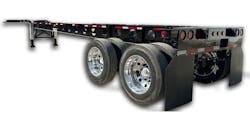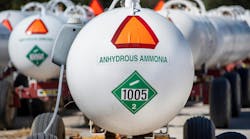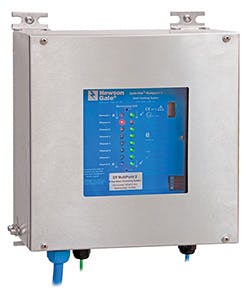The loading and unloading of tank trucks with flammable and combustible products, presents one of the most serious fire and explosion risks for site operations within the hazardous process industries, according to experts at Newson Gale, a supplier of static grounding technology.
A study conducted by the American Petroleum Institute (API) in 1967 identified static discharges as being responsible for over 60 incidents in tank truck loading operations, demonstrating just how long this potential threat has been acknowledged. The natural presence of static electricity in product transfer operations, combined with its associated ignition hazards, ensures that regulators take static control precautions for tank trucks very seriously.
Powders and liquids with low electrical conductivities are the prime sources of static charge generation because their electrical properties do not easily permit the transfer of excess charges. Instead, non-conductive and semi-conductive liquids and powders retain and accumulate charges after they make contact with conductive objects. The most common interface for charging of non-conductive and semi-conductive product is contact with metal plant equipment including pipes, filters, pumps, valves, barrels, totes, mixers, and agitators. When the electrostatically charged liquid (or powder) is deposited into a container like a barrel, tote, or cargo tank charging of the container will occur if there is nowhere else for the charges to go. In this situation the charges are “static”, accumulate on the surface of the container, and set up a potential difference with respect to ground.
For sparking to occur in tank truck product transfer operations, other conductive objects must come into close proximity with the charged container of the tank truck. Examples of conductive “objects” include the fill pipe entering the opening on the top of the container, fall prevention systems like folding stairs, and drivers or operators working around the tank truck.
The charges on the tank truck’s container attract opposite charges to the surface of the object and rapidly create an electric field between their respective surfaces. It is the strength of this electric field that causes the “breakdown” of the air between the container and the object. When the air is “broken down” a conductive path for the excess charges to rapidly discharge themselves is created, leading to a static spark discharge. If a combustible atmosphere is present in this space, ignition of the atmosphere is very probable. Under ambient conditions an average field strength of 30 kilo-volts is capable of causing the electrical breakdown of air over a spark gap of 0.8 inches.
In addition loose conductive items located inside the container could become charged by contact with the liquid and discharge to the container if they are capable of floating on top of the liquid. It is important to carry out regular visual inspections of the container to ensure loose debris is not present inside the tank truck container.
As outlined earlier, regulators are extremely cautious about the ignition hazards presented by static electricity in tank truck product transfer operations. Three standards, in particular, provide clear guidance on what precautions should be taken. NFPA 77, API RP 2003 and IEC 60079-32 state that grounding of the tank truck should be the first procedure carried out in the transfer process. Grounding effectively creates an electrical circuit that connects the tank truck to the Earth and it is this connection to earth which prevents static charges accumulating on the tank truck’s container. The reason the charges can transfer from the tank truck to earth is because the Earth has an infinite capacity to absorb and redistribute static charges, with the positive effect of removing the ignition source from a potentially combustible atmosphere.
The electrical resistance of this circuit from the tank truck to the “ground source” (or “grounding point”) which is in contact with the earth, is a key performance indicator of the entire grounding circuit’s capacity to provide a secure and safe product transfer operation. NFPA 77 and API RP 2003 state the resistance in a healthy metal circuit should never exceed 10 ohms, therefore the entire circuit between the truck and grounding point should be measured and be equal to, or less than, 10 ohms. If a resistance above 10 ohms is measured this will indicate problems with parts of the grounding circuit including the tank truck connection, the ground point connection or the condition of the conductor cable.
The standards state that a grounding system, which can measure and monitor resistance in the grounding circuit, can be utilized. The system should verify if the ground connection to the tank truck is complete before loading or unloading is initiated. The precautionary guidance regarding the grounding of road tankers in IEC 60079-32 reflects the IEC’s stated goal of providing the latest state of the art guidance. It states that the “earth cable” earthing the road tanker should be part of a static grounding system that continuously monitors the resistance between the road tanker and the designated grounding point located on the loading gantry. It states that the grounding system should be interlocked with the transfer system to shut down the product transfer operation if this resistance exceeds 10 ohms. It also states that the grounding system should be capable of recognizing when it is not connected to the chassis/tank of the road tanker. This ensures that situations where the tank of the road tanker is not connected to the grounding system, for example, where an operator could connect the clamp to an isolated metal mud-guard or wheel-nut, will not result in a permissive condition for the transfer operation, thereby eliminating the risk of electrostatic charging of the road tanker.
An additional recommendation in NFPA 77 and API RP 2003 calls for interlocking the feed system (ergo pump) with the grounding system so that if the grounding system is not connected to the tank truck, product cannot be transferred. This will ensure that product cannot enter or leave the tank truck when the tank truck has no grounding protection in place. In general, interlocked grounding systems will complete the grounding circuit when the driver connects the clamp of the grounding system to the tank truck and the system sees a circuit resistance of 10 ohms or less. Although the standards recommend a monitored resistance of 10 ohms, there are many grounding systems on the market today that monitor well in excess of this level.
While it may be claimed that these systems are capable of dissipating static charges the capacity of a system to monitor at 10 ohms, not only provides an opportunity to demonstrate compliance with internationally recognised recommended practice, it also means that hazardous location operators know the system’s grounding clamp is making a secure and reliable connection to the tank truck every time a product transfer is carried out. Grounding clamps should be designed to penetrate paint coatings, rust and general dirt build up as they are very effective at impeding secure electrical contact with the conductive metal of the tank truck.
Additionally, the grounding system must be capable of detecting minute changes in resistance when the transfer is underway and should not allow a high degree of change in resistance before shutting down the pump or alerting personnel. As soon as a resistance above 10 ohms is present in the grounding circuit, the grounding system should be capable of detecting this change and take control of the feed into the tank truck. Systems that permit resistances higher than 10 ohms have a greater degree of difficulty in detecting changes in the health and condition of the grounding circuit.
Because resistance monitoring systems operate when connected to conductive metal objects, additional features can enhance the protection of drivers, product and equipment. A “tank truck recognition” feature can be utilized to ensure that drivers can only operate the feed system when the grounding system detects it is connected to a tank truck. A system like the Earth-Rite RTR will analyse the capacitance of the tank truck as part of the grounding circuit. If the capacitance presented is in the normal range for tanks trucks, the grounding system will recognise that it has made a positive connection to a tank truck. From the site operator’s perspective, this eliminates the risk of drivers unknowingly connecting the grounding clamp to parts of the truck chassis that are electrically isolated from the truck’s container. This isolation may be due to original design oversight like isolated mud guards or paint coatings insulating conductive parts like truck light enclosures from the chassis. In addition drivers have been known to attach the grounding system’s clamp to the loading rack in order to obtain a permissive state for the feed system to “speed up” the transfer.
So while a permissive state for the feed system can be obtained with a standard resistance based monitoring system it does not necessarily mean the grounding clamp is electrically connected to the tank truck’s container. Specifying a grounding system with a tank truck recognition feature ensures the tank truck is safely grounded before drivers are in a position to begin filling it with product. Once the system has verified it is connected to a tank truck it should then monitor the tank truck’s connection to the grounding point to 10 ohms, or less.
When a tank truck grounding system is installed it is assumed that the ground source (ergo buried ground electrode) to which the system is connected has been independently verified as having a low resistance connection to earth. This connection is the foundation for secure and safe transfers and it is incumbent on the site operator to conduct seasonal “Fall of Potential” tests to ensure these ground connections do not deteriorate due to changes in soil composition, soil resistivity or corrosion of the ground electrode.
In winter, ground temperatures can reduce dramatically and cause an exponential increase in soil resistance levels. For the ground electrode these temperatures can have a significant impact on its contact resistance with the soil potentially impeding the transfer of static charging currents.
Standard grounding systems are not designed to verify this connection, however, the patented Earth-Rite RTR can remove this uncertainty. This system has a unique feature which verifies that it is connected to a grounding point which is capable of safely dissipating static charges to ground. In combination with tank truck recognition capability, this “static ground verification” function ensures that two vital connections in the grounding process are securely made before product is allowed to leave or enter the vehicle.
When both of these connections are confirmed, the system will continuously monitor the resistance of these connections at 10 ohms (or less) for the duration of the transfer process. Should either connection be opened during the transfer, the system will detect this and switch off power to the pump or valve actuators in order to stop the feed of charged liquids into, or out of, the tank truck.
In accordance with the recommendations of industry groups and fire safety associations, the static grounding of tank trucks is a key safety protocol in the loading or unloading of flammable and combustible products. Grounding ensures static charges are not permitted to accumulate on the tank truck eliminating the risk of the container becoming an ignition source. Additionally, national and international recommended practice advocates the adoption of static grounding parameters that will enhance the safety of the product transfer process including monitoring the grounding circuit to 10 ohms or less and interlocking the product feed system with a dedicated grounding system.
When selecting tank truck grounding systems, specifiers should also consider additional functions that can enhance the safety of the transfer process. Grounding systems which include tank truck recognition and static ground connection verification functions provide additional guarantees that a transfer process cannot take place unless the tank truck is connected to the grounding system and the grounding system itself is connected to a verified ground source. These features enhance the secure grounding of the tank truck and enable hazardous area operators demonstrate the highest levels of compliance with NFPA 77, API RP 2003 and IEC 60079-32.










